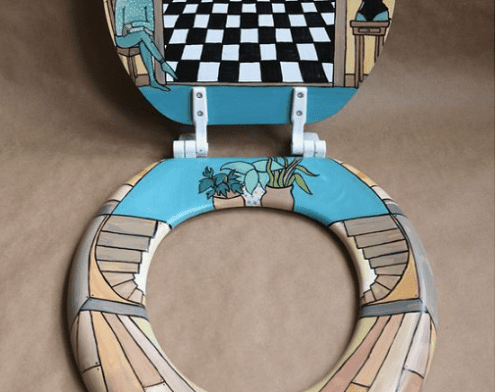If you own a toilet with a wooden seat, you are well aware that wood is susceptible to moisture degradation. Besides constant exposure to moisture, your wooden toilet seat may also degrade due to frequent cleaning with chemical products. The gradual wear-off will make your ceramic throne lose its aesthetic appeal, calling for repainting or resealing. This guide specifically highlights how to seal a painted toilet seat to enhance aesthetics and prolong its life.
How to Paint a Wooden Toilet Seat
Painting and sealing your wooden toilet seat helps you deal with the woes related to moisture degradation. Besides, you can do it yourself and save the costs of acquiring a new toilet seat. Toilet seats made of pine, veneer, mahogany, oak, or medium-density fiberboard need special treatment to prepare them for a paint job.
To paint your wooden toilet seat, you require a spray primer and spray paint. Additional items include a drop cloth, sandpaper, disinfectant cleaner, painter’s tape, and a sponge.
With everything ready, here are the steps involved in painting a wooden toilet seat:
- Remove the wooden toilet seat by loosening the nuts with a spanner.
- Lay the nuts, bolts, and toilet seat on a drop cloth in a ventilated area.
- Clean the seat thoroughly with a bristle brush and disinfectant cleaner. Use a moist sponge to rinse the toilet seat and allow it to dry.
- Demarcate the sections you intend to paint with painter’s tape.
- Sand the toilet seat sections you intend to paint with fine-grit sandpaper to achieve a dull finish. Remember to get rid of particles on the sanded areas with a moist sponge.
- Spray primer on the dry sanded surfaces. Use an agile, sweeping motion to reach all the areas you plan to paint later.
- Allow the primer to dry.
- Spray the first coat of paint on the demarcated sections.
- Once the coat dries, apply the second coat of paint and allow it to dry.
- Remove the painter’s tape and reinstall the toilet seat in its original position.

How to Seal a Painted Toilet Seat
Painting your wooden toilet seat is often not enough. It would help if you also sealed it to protect it from moisture, peeling, and physical damage. Prolonged exposure to moisture can also cause your wooden seat to warp.
It’s always important to identify the type of wood your toilet seat is made of before applying a sealant. Most softwoods are particularly susceptible to warping due to their relatively high porosity. Notably, hardwoods such as boxwood, ironwood, and ebony are less vulnerable to warping and don’t need as much sealant as softwoods.
What Type of Sealant Should You Use On a Toilet Seat?
Once you finish painting your wooden toilet seat, you will likely ask yourself the type of sealant you should use. Well, the answer is quite simple. If you used acrylic spray paint on your wooden toilet seat, you could choose from various types of sealants, including:
1. Polyurethane
Polyurethane is ideal for sealing the coat of paint on your wooden toilet seat because it provides a fine, glossy finish. The sealant comes in two varieties: an oil-based and a water-based variety. Typically, oil-based polyurethane is more durable than water-based variety.
When choosing the ideal variety, you should also consider its drawbacks. Water-based polyurethane is less resistant to heat, while oil-based polyurethane discolors over time. Notably, both varieties of sealant are water-resistant.
2. PVA Glue
PVA Glue is a relatively affordable sealant you can use to seal your painted toilet seat. To achieve the right consistency, you only need to add water to the sealant in equal parts. You should then use a brush to apply the watered-down PVA Glue on wooden surfaces.
3. Furniture Wax
Furniture wax is an apt solution to issues a wooden toilet seat may present. You only need to apply it to your painted toilet seat with a cloth. The sealant prevents the paint on your wooden toilet from peeling over time.
4. Mod Podge
Mod Podge is a relatively affordable sealant that makes the paint coating on your wooden toilet seat waterproof. The sealant does not discolor over time and gives your wood surface a glossy appearance. You should use a hand brush to apply mod podge on your desired surface. Notably, you apply as many coats as you want in 20-minute intervals.
5. Polyacrylic Sealant
You can also use a polyacrylic sealant to seal your painted toilet seat because of its wide-ranging advantages. The sealant protects your painted wood surface from moisture, fluctuating temperatures, and sunlight. The polyacrylic sealant also dries fast and is relatively affordable.
The polyacrylic sealant comes in either a spray or an ordinary canister. Use a synthetic brush to apply the sealant on your painted wood surface if you choose the latter. Ideally, you should apply at least two layers for better protection.
6. Gel Medium
Gel medium provides a satin finish on your painted toilet seat. You need a sponge, brush, or roller to smear and spread the sealant on your desired surface. Gel medium lasts for a long time upon drying.
7. Clear Sealant
A clear sealant protects the paint coating on your wooden toilet seat from physical damage and moisture. The product provides a glossy finish invulnerable to temperature fluctuations in outdoor and indoor environments. The sealant ordinarily comes in a spray can.
Notably, you should move the spray canister over your wooden toilet seat in a smooth and agile motion. It is advisable to spray clear sealant in a well-ventilated area to avoid inhaling it. Consider applying more than two layers for maximum effect.
8. Epoxy Resin
Epoxy resin gives the paint coating on your wooden toilet seat unmatched protection. The sealant comes in different varieties, which provide a glossy finish. An epoxy resin kit ordinarily includes a hardener and resin.
You need measuring cups to measure equal parts of the two substances. Additionally, you should pour the substances into a mixing vessel and stir to achieve consistency. Once the mixture is ready, pour it onto the painted areas of your wooden toilet seat and allow it to dry.
9. Varnish
Varnish gives the paint coating on your wooden toilet seat a durable, glossy finish. Notably, the sealant comes in two varieties, namely, an acrylic polymer and an acrylic resin variety. Your choice of varnish will largely depend on your preferences.
Notably, acrylic resin gives a glossier finish than acrylic polymer. However, acrylic resin is more toxic than acrylic polymer. It would help if you considered applying acrylic resin in an outdoor environment.
10. Glaze
The glaze is a relatively affordable sealant that gives you great value for money. Once you apply it to the paint coating of your wooden toilet seat, it provides a durable, glossy finish. You should use a synthetic brush to apply glaze to the painted sections of your wooden toilet seat.
The glaze has its fair share of disadvantages. It is worth noting that the sealant has considerably low heat resistance. Additionally, it is only ideal for indoor use. You can apply more than one layer of the sealant at 30-minute intervals for maximum effect.

Steps Involved In Sealing a Painted Toilet Seat
Once you select the sealant that suits your needs, you should then apply it to the paint coating of your wooden toilet seat. You require several tools to accomplish this task. The tools include rags, protective gear, a drop cloth, a paintbrush, sandpaper, and rollers.
After gathering your tools, you need to find a spacious and well-ventilated work area. Consider choosing an outdoor space to avoid inhaling sealant particles. Begin by wiping the surface of your wooden toilet seat with a cloth.
You should then use a roller, synthetic brush, or a sponge to apply a sealant to your wooden toilet seat. Remember to read the instructions written on the sealant container to determine the specific period you should leave it to dry. You can apply more than one layer in the specified time intervals.
Once dry, sand the sealed surface with fine-grit sandpaper and then wipe it off. Next, apply a suitable primer such as acrylic gesso on the sanded surface. Leave the primer to dry and sand it with fine-grit sandpaper if the resulting surface is uneven.
You can repeat the procedure more than once, depending on the number of layers you desire. If you use a spray canister to apply sealant, you should consider doing it in an outdoor space. It would help if you also held the spray can roughly 30 centimeters above the painted toilet surface.
Helpful Tips for Applying Sealant on Painted Toilet Seats
- Thin layers of sealant are always better than a few thick layers.
- Consider choosing the sealant with a glossy finish because it has more outstanding durability.
- Exercise patience when applying layers of sealant because they take time to dry.
- Inspect the nozzle of your sealant can regularly to prevent clogging.
- Shake the spray can vigorously before using it.
- Toilet seats made of hardwood require relatively fewer sealant layers than softwood toilet seats.
- Test your resin on a dummy surface before pouring it on your wooden toilet seat.
- Always minimize atmospheric dust particles by spraying water around your work area.
So, there you go. Please share with us your experience painting and sealing your wooden toilet seat and the type of sealant you found effective!
